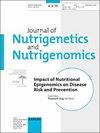肠道菌群和个性化营养。
Q Agricultural and Biological Sciences
Journal of Nutrigenetics and Nutrigenomics
Pub Date : 2013-01-01
Epub Date: 2013-06-14
DOI:10.1159/000353144
引用次数: 18
摘要
本文章由计算机程序翻译,如有差异,请以英文原文为准。
Gut microbiota and personalized nutrition.
The gut microbiota has recently attracted unprecedented attention from the biomedical community for the mounting evidence supporting its central role in human health and disease [1] . The gut microbiota consists of the trillions of bacterial microorganisms, spanning over 500 species, that inhabit our gastrointestinal tracts. We now know that these bacteria are not simply commensal organisms in our bodies, but instead serve as an important ‘organ’ that regulates metabolic processes, including the digestion and absorption of nutrients, synthesis of vitamins, modulation of mucosal immunity, as well as production of toxins and carcinogens [1, 2] . The composition of the gut microbial community – whether the bacterial numbers are balanced or in dysbiosis – determines the nature of its influence on numerous physiological and pathological conditions. Since the gut microbial profile is unique to each individual, evolves over a lifetime, and can be altered by internal and external factors (especially the diet), the gut microbiome presents us with further complexities as well as new opportunities for nutrigenomics and personalized nutrition. When we study the effects of dietary nutrients on gene expression, we must be aware that these effects can be mediated by gut bacteria. The gut microbiota can influence gene expression both locally and systemically. Through interactions with the intestinal mucosal tissue, certain species of bacteria can influence the expression of genes involved in nutrient absorption or immune function [3] , while some substances generated by gut bacteria can enter the bloodstream; for example, short-chain fatty acids (produced by fermentation of polysaccharides) can regulate lipogenesis gene expression in the liver, and toxins like lipopolysaccharides (LPS) can affect inflammation-related genes [4] . The quantities of these bacteria, such as the LPS-producing Escherichia coli , can be significantly altered by dietary nutrients. For example, a diet high in saturated fat has been shown to increase E. coli and subsequent LPS production [5] , while a laminarin-supplemented diet can suppress E. coli numbers and result in lower levels of inflammatory cytokines [6] . These findings illustrate a new interface for the regulation of gene expression by dietary nutrients, and also reveal an alternative pathway for regulating gene expression through the manipulation of the gut microbiota.
求助全文
通过发布文献求助,成功后即可免费获取论文全文。
去求助
来源期刊

Journal of Nutrigenetics and Nutrigenomics
GENETICS & HEREDITY-NUTRITION & DIETETICS
CiteScore
1.86
自引率
0.00%
发文量
0
审稿时长
>12 weeks
期刊介绍:
The emerging field of nutrigenetics and nutrigenomics is rapidly gaining importance, and this new international journal has been established to meet the needs of the investigators for a high-quality platform for their research. Endorsed by the recently founded "International Society of Nutrigenetics/Nutrigenomics", the ‘Journal of Nutrigenetics and Nutrigenomics’ welcomes contributions not only investigating the role of genetic variation in response to diet and that of nutrients in the regulation of gene expression, but is also open for articles covering all aspects of gene-environment interactions in the determination of health and disease.
 求助内容:
求助内容: 应助结果提醒方式:
应助结果提醒方式:


